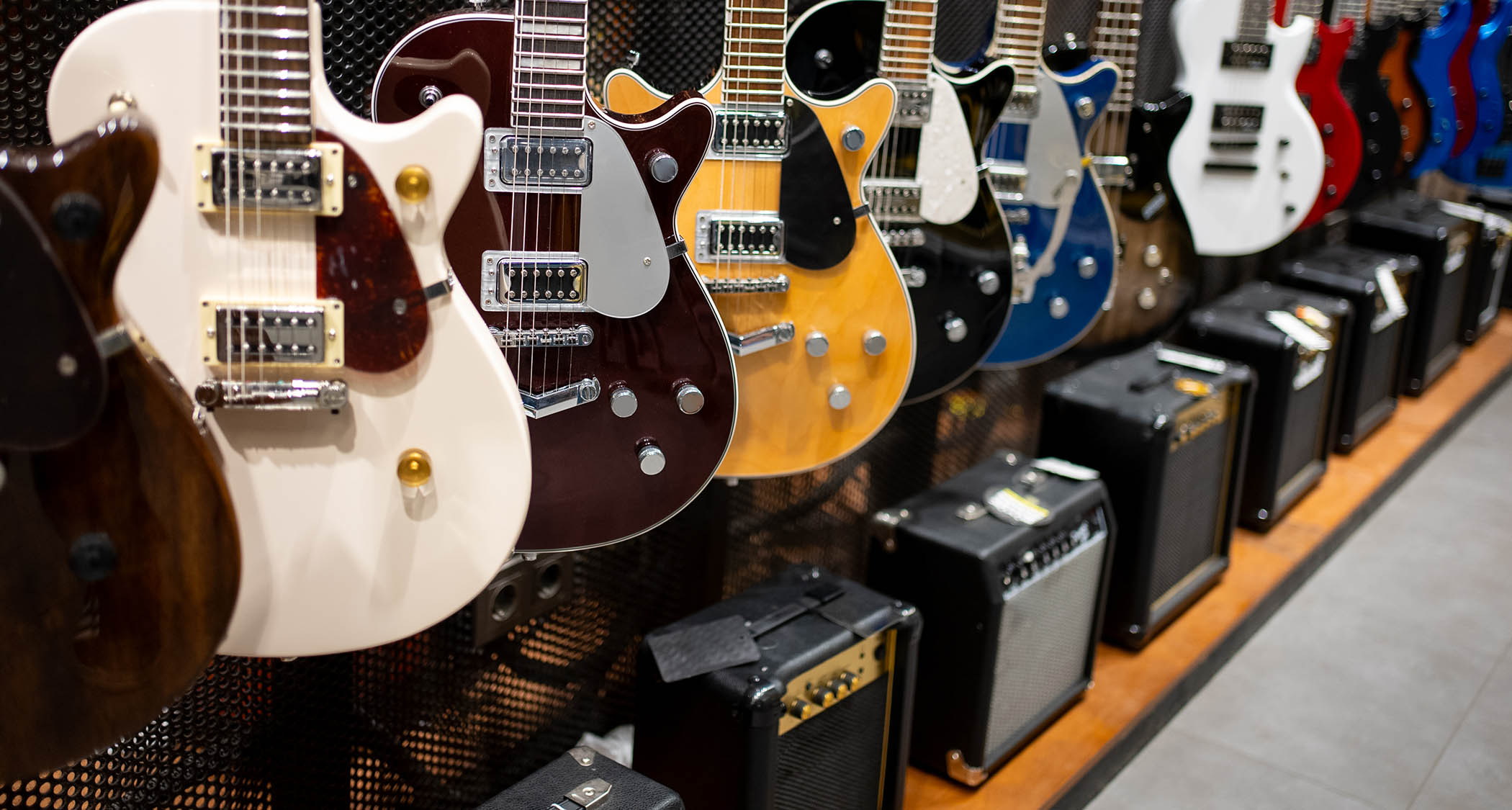Everything you need to know about seven- and eight-string guitars
Six strings just not cutting it anymore? The world of extended-range electrics can be dizzying, but we've simplified it all for you right here

Ibanez Introduced the industry’s first mass-produced 7-string solidbody electric guitar - the Universe UV7, designed in collaboration with Steve Vai - in 1990.
Although guitarists overwhelmingly applauded this new innovation that expanded the instrument’s range, Ibanez surprisingly discontinued their Universe model seven-string guitars in 1994 after an unusually short period of production. This caused a few music industry observers to prematurely conclude that the seven-string guitar was just a passing fad with little more than novelty appeal.
The timing of the discontinuation was unfortunate, however, as seven-string guitars were just starting to catch on with an increasing amount of players around the same time.
During the mid-'90s an impressively diverse variety of bands and guitarists embraced and popularized the heavier sound of the seven-string guitar, including Cannibal Corpse, Deftones, Dream Theater, Fear Factory, Korn, Meshuggah, Morbid Angel, Nevermore, Uli Jon Roth, Voivod and many others.
Guitarists who favored the extended range of a seven-string guitar grew to significant ranks over the next few years, and Ibanez soon reversed course and started building seven-string models again in 1997.
Other major manufacturers also introduced seven-string models during this time, although it took almost another decade before several companies started to offer more than just a handful of seven-string models in their product lineups.
The market for seven-string guitars has changed radically over the past 15 years, as have the designs of many of the instruments. Today guitarists can choose from several hundred different models, and a handful of manufacturers each even offer a larger variety of models than what the entire industry provided at the dawn of the new millennium.
All the latest guitar news, interviews, lessons, reviews, deals and more, direct to your inbox!
About the same time as the seven-string surge took place around a decade or so ago, a handful of companies started to offer the first mass-produced eight-string models, providing yet another tempting alternative instrument for guitarists interested in exploring a wider sonic range than that of a standard six-string guitar.
Over time, the design of the seven-string guitar has expanded to include instruments with extended scale lengths and alternate tunings, which has made the decision process more confusing for newcomers as well as experienced guitarists shopping for their first seven- or eight-string guitar.
While the basic features on a standard six-string and seven- or 8-string guitar are essentially the same, many of these attributes on seven- and eight-string guitars require more careful consideration based on how one plans on playing the instrument (such as riffs, solos, chords and rhythm or all of the above), the tuning one prefers to use (standard, drop tuning or alternate tunings) and other playing and performance details.
Fortunately, price is no longer as much of an issue as it once was (the high cost of the first Ibanez Universe guitars accounted probably more than anything for their initial failure to catch on), and a wide variety of budget-priced instruments are available to choose from as well as expensive boutique models that can be customized to a player’s preferences.

To help demystify today’s seven- and eight-string guitars, we’ve put together the following shopper’s guide that discusses several of the most important features to consider before making a choice.
In some respects, the seven- and eight-string guitar are almost like entirely new instruments, but the differences between them and standard six-string guitars is not as vast as the gap between a six-string guitar and a bass. Once a guitarist knows what to look for, buying one’s first seven- or eight-string is as easy as choosing another guitar to add to one’s growing collection.
Scale length
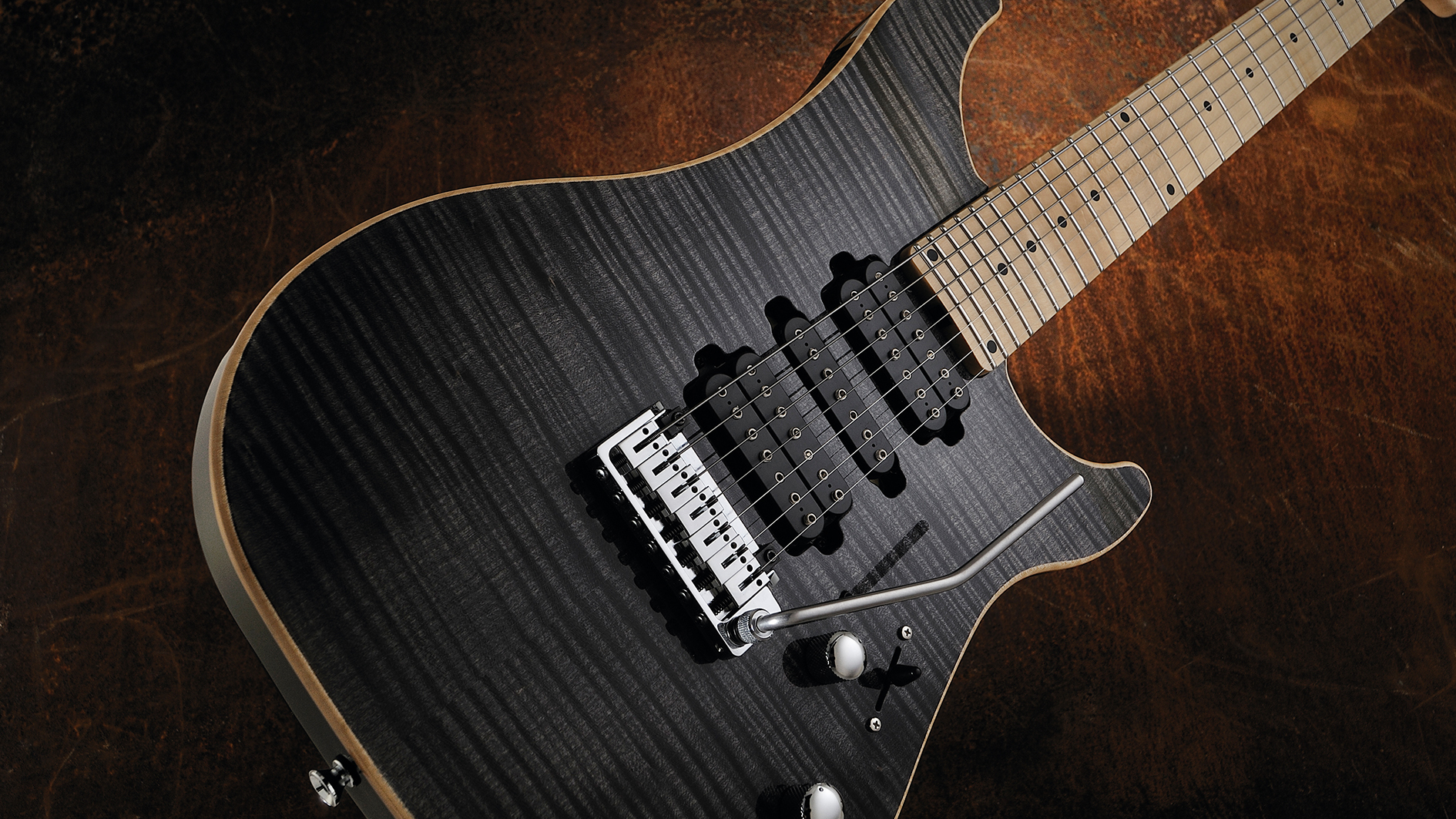
Probably 99 Percent of all six-string solidbody electric guitars made today have scale lengths that fall somewhere between 24.5 and 25.5 inches, but the scale lengths found on seven-string guitars span a much wider range, generally between 25.5 inches to 27 inches or above.
Eight-string guitars typically have scale lengths that are at least 27 inches, while a handful of examples (like the Ibanez M80M Meshuggah signature) measure almost 29.5 inches long. For a guitarist who is used to playing a Gibson Les Paul with a 24.75-inch scale, playing a guitar with a scale that is 1.5 inches longer or more than they’re used to can literally prove to be quite a stretch.
A seven-string guitar with a 25.5-inch scale is the best choice for a six-string guitarist looking to make a quick, easy and comfortable transition. However, instruments with longer scales offer certain sonic advantages, particularly for players who want to tune down the lowest string a whole step or the entire guitar a whole step or more.
On a shorter scale guitar, tuning down reduces string tension to a point where the lowest strings can feel too slinky and loose, which also makes those strings difficult to play in tune as even the slightest amount of excess pressure while fretting notes can bend the pitch. Some players use heavier string gauges to compensate, but intonation can become problematic for heavier gauge strings on shorter scale instruments and heavier gauge strings may not fit into the tuning pegs.
Fanned fret instruments provide the best of both worlds - shorter scale lengths for the treble strings and longer scale lengths for the bass strings
Longer scale lengths require greater string tension when tuning to the same pitch as a shorter scale instrument, which allows players to use lighter string gauges that they are more comfortable with (especially on the high E string) instead of the heavier gauge strings required to maintain adequate tension on instruments with shorter scales. Conversely, longer scales allow players to use heavier strings at lower tensions, which can make heavy strings easier to play, especially when bending notes.
Several companies now offer seven-and eight-string guitars with fanned frets (also known as multiple-scale fretboards), where the nut, bridge and frets are installed at varying angles instead of perpendicular to the strings. These instruments provide the best of both worlds - shorter scale lengths for the treble strings and longer scale lengths for the bass strings - delivering the comfortable “slinky” playability guitarists prefer for the treble strings along with bright tone and reliable intonation afforded by adequate tension on the bass strings.
Fanned scale lengths generally range from 25.5 inches for the high E string to 26.5 or 27 inches for the low B string, or even as much as 25.5 to 28 inches for an eight-string instrument.
Nut width

The rule of thumb for seven- and eight-string guitars is basically the same as it is for a six-string guitar: narrower nut widths are generally more comfortable for players with smaller hands while wider nut widths are better for players with bigger hands or who want more space in between each string to facilitate fretting notes more cleanly.
Depending on the nut width of a seven- or eight-string guitar, the addition of an extra string or two can result in strings that may feel too close to each other or a neck that feels uncomfortably wide and unwieldy. This is one instance where guitarists need to try out instruments before they buy to see how comfortable the neck width feels in their hands.
Some seven-string necks are as narrow as 42 or 43 millimeters (certain ESP and Caparison models, for example), which is about the same nut width as a standard six-string Stratocaster, so with the addition of an extra string the strings are now much more closely spaced together.
Try playing riffs and chords all over the neck, while paying attention to the fretboard’s width up and down the neck to evaluate the instrument’s overall comfort and playability
Players who prefer the same average string spacing as a six-string guitar should look for seven-string guitars with nut widths around 47 to 48mm. However, if you’re using lower tunings you may prefer to opt for even wider nuts that measure 49 to 51mm to provide the lowest bass strings more room to vibrate freely and make it easier to finger chords when using heavier gauge strings.
It’s particularly essential to try out an eight-string guitar as some players may find instruments with wide string spacing very difficult to play, particularly when fretting chords on the lower strings. Some players may find that eight-string guitars with the same string spacing that they’re normally accustomed to on six-string instruments are impossible to play, so a narrower nut may be the better option.
Try playing riffs and chords all over the neck, while paying attention to the fretboard’s width up and down the neck to evaluate the instrument’s overall comfort and playability. Having to adjust your playing style is normal at first, but if your fretting hand feels stiff or sore after a few minutes you’ll probably want to try instruments with wider or narrower string spacing until you find your personal comfort zone.
Neck profile/radius
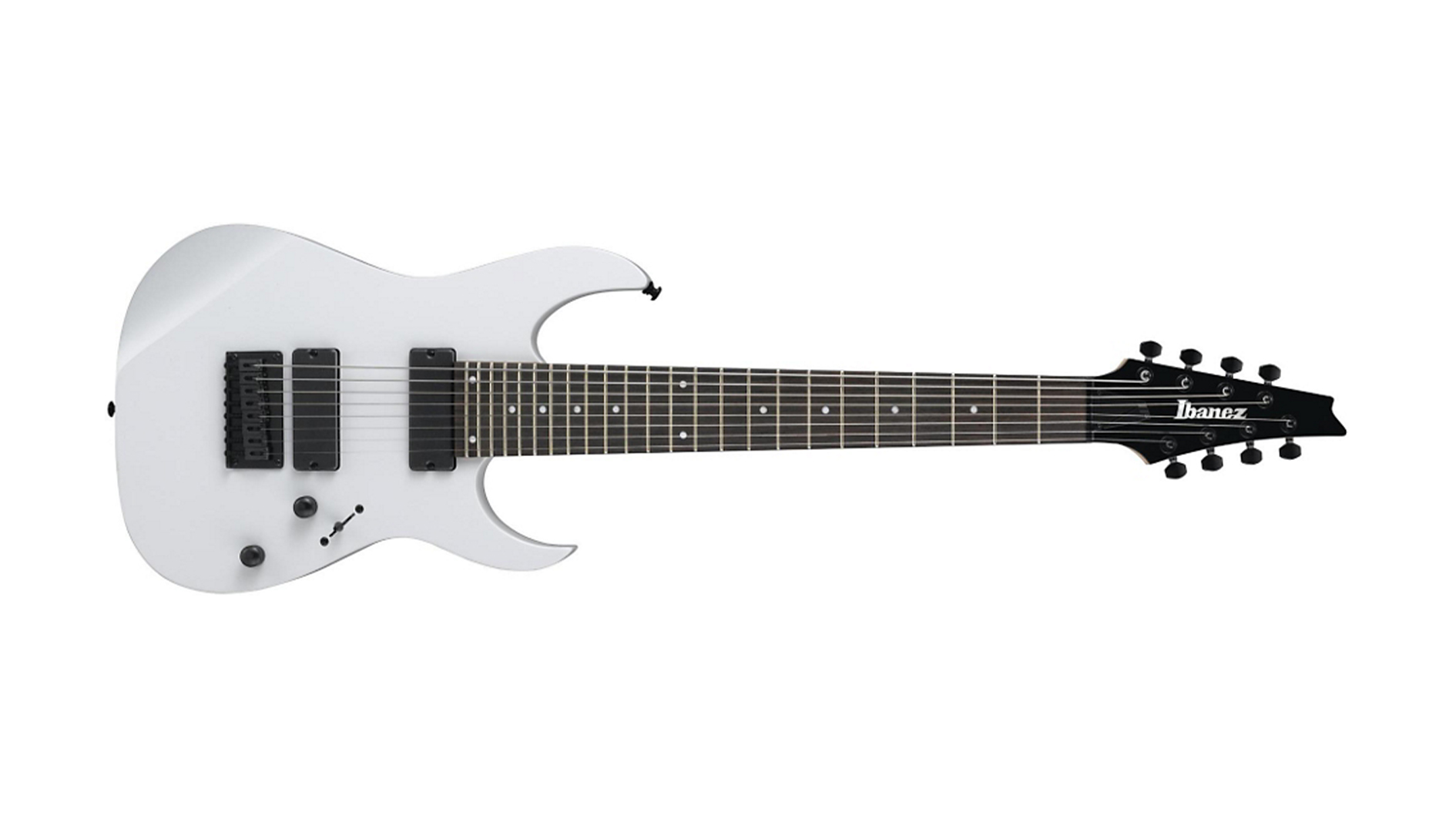
Because the necks on most seven-and eight-string guitars are wider than those on six-string guitars, the shape of the neck profile and curvature of the radius can seem more exaggerated. Generally, most seven-string and particularly eight-string guitars have thin and relatively flat profiles as even an average C-shaped profile can seem overly thick and unwieldy. The trade-off for the easier, faster playability of a flat, thin neck profile is that the tone may not be as full and rich or the neck may not always feel solid, so you have to determine your priorities here.
Be particularly careful when considering cheaper instruments with flat, thin neck profiles as the materials, construction and truss rod support may not be solid enough to handle the excess string tension, causing the neck to bend easily (and tuning stability to go out the window) when playing. Try strumming the open strings while applying steadily increasing pressure to the back of the headstock as if you’re pushing the headstock forward. If the pitch dives with only slight pressure, you might want to consider an instrument with a more solid and sturdy feeling neck that doesn’t budge as easily.
Most seven- and eight-string guitars also have a larger, flatter radius than a standard six-string guitar. While a vintage Tele’s 7.25-inch radius may seem perfectly fine (especially if you just play open cowboy chords on the lower frets), on a wider seven- or eight-string neck it will seem absurdly rounded.
On a wider neck, even a 12-inch radius will have noticeable curvature. Fretboards with a radius of 15 inches or larger more closely replicate the “flat” feel of a modern six-string shred guitar neck. Many models feature a compound radius that becomes flatter further up the neck, which can make it easier to play chords in the lower registers while facilitating string bending further up the neck.
String gauges

One common overlooked consideration is the gauges of the strings that the instrument was designed to use. Never assume that any seven- or eight-string guitar can accommodate whatever gauges of strings the player plans on using. For example, players who find the lowest string on a 25.5-inch scale guitar too loose and floppy may want to use heavier gauges on the lowest strings, but on some guitars the hardware may have difficulty accommodating strings that are wider than .060 inches.
The hole or slot in the tuning peg may not be wide enough, or the string may be too wide to fit into a locking nut or the holes for a stop, through-body and tremolo tailpiece where the ball end (or string end) is anchored. Also, on a shorter scale guitar the bridge saddles may not provide enough travel to properly intonate heavier low-end strings, so the bridge will need to be either replaced or moved. On some instruments the action may be too low to accommodate heavier strings, which can cause fret buzz and other problems that one may not be able to fix by adjusting the bridge and/or truss rod.
Hardware can be modified or replaced, but in the long run it’s better to get an instrument that can accommodate the strings you plan on using right out of the box, as modifications can cause strings to break easily if not performed properly and replacement parts may not always fit properly. It’s better to get an instrument that’s right from the beginning. There are so many different models available today that one should be able to find an instrument that can handle a player’s preferred string gauges without modification.
Tuning
The most common tuning for a seven-string guitar is (low to high) B-E-A-D-G-B-E, and for an eight-string it’s usually the same but with the addition of the lowest string tuned to F#. Some players prefer to tune the lowest string down a whole step to A on a seven-string or to E on an eight-string.
However, don’t assume that all seven- or eight-string guitars are designed to accommodate these tunings. Some instruments, particularly those with longer scales and/or heavier strings, may be designed to be tuned down a whole step or more, or they may be designed as baritone instruments with heavier string gauges better suited to playing chords and riffs instead of solos and bent notes.
Before you go into the guitar store or place an order online, do a little research to verify what tuning the instrument was designed to best accommodate. Also, bring a tuner or smart phone with a tuning app with you (unless you have perfect pitch) to make sure that the instrument you’re trying is properly tuned so you can better evaluate how it is supposed to play and feel as shipped from the factory.
Ergonomics
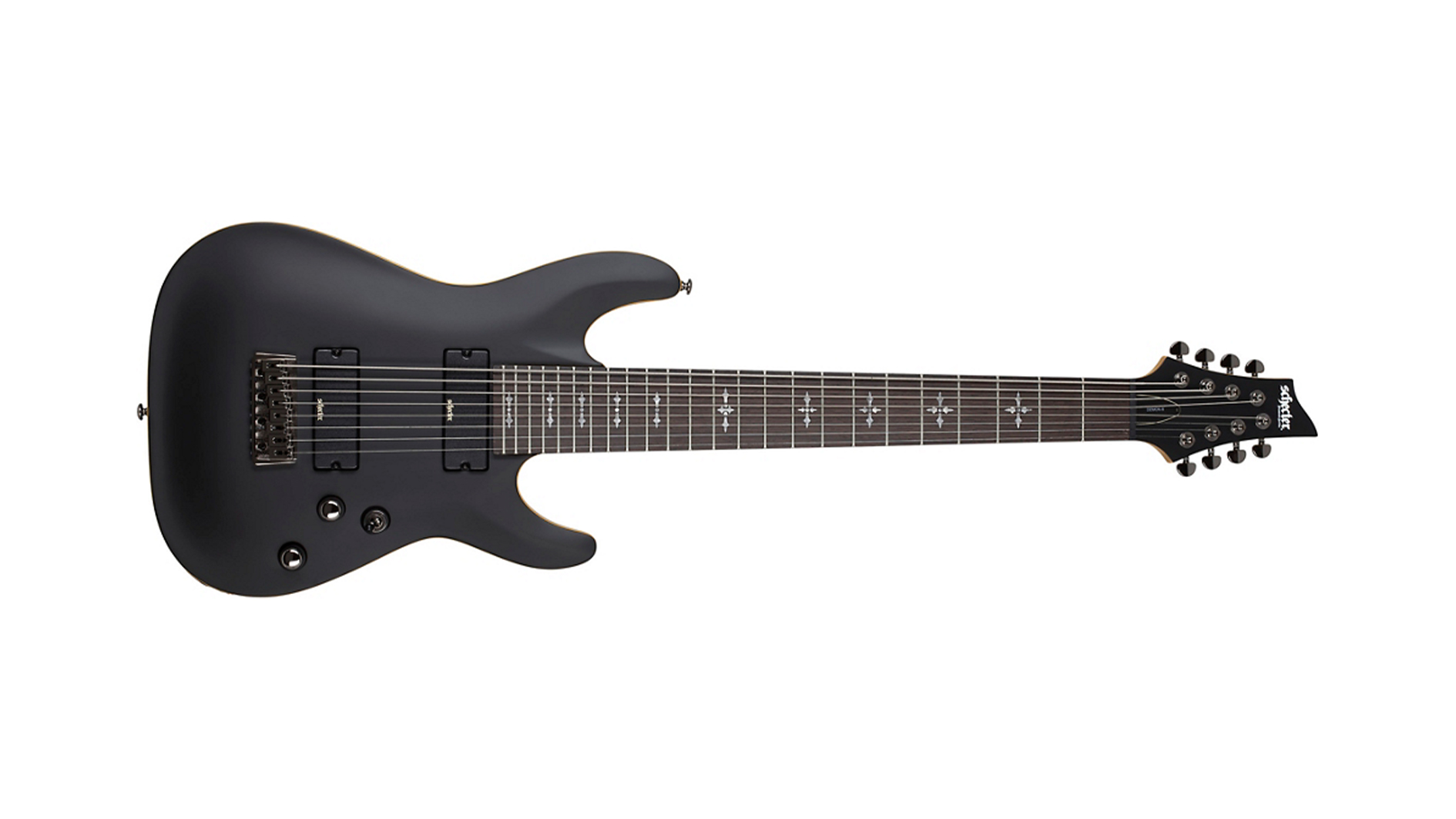
Because many seven- and eight-string guitars have wider and longer necks, the neck may also be heavier and not well balanced with the body. It’s important to try the instrument with a strap in a standing position to make sure that the headstock doesn’t dive to the ground unless you’re okay with supporting the neck an entire gig with your fretting hand. Ideally the guitar should constantly remain in a balanced, comfortable playing position whether you’re standing up or sitting down.
Many seven- and eight-string guitars also have wider and longer bodies, so make sure you’re comfortable with the larger size. Body contours can increase playing comfort, but make sure that they conform or fit to your body and arm positions. Instruments with neck-through-body or set-thru designs usually have a seamless transition where the neck meets the body compared to the bulky heels on most set neck and bolt-on neck designs.
As a result, a neck-through-body or set-thru instrument is usually more comfortable for guitarists who often play above the 15th fret, although plenty of guitarists aren’t really bothered by neck heels. It’s all a matter of what’s really important and comfortable to you.
Most seven- and eight-string guitars weigh about the same or a little more than a standard six-string solidbody, but don’t be discouraged should you find a model that you particularly like that’s a little heavier than you’re used to.
Using a wide strap and wearing the instrument a little higher and closer to your body can compensate for the added weight to the point that you won’t notice the difference.
Electronics/pickups
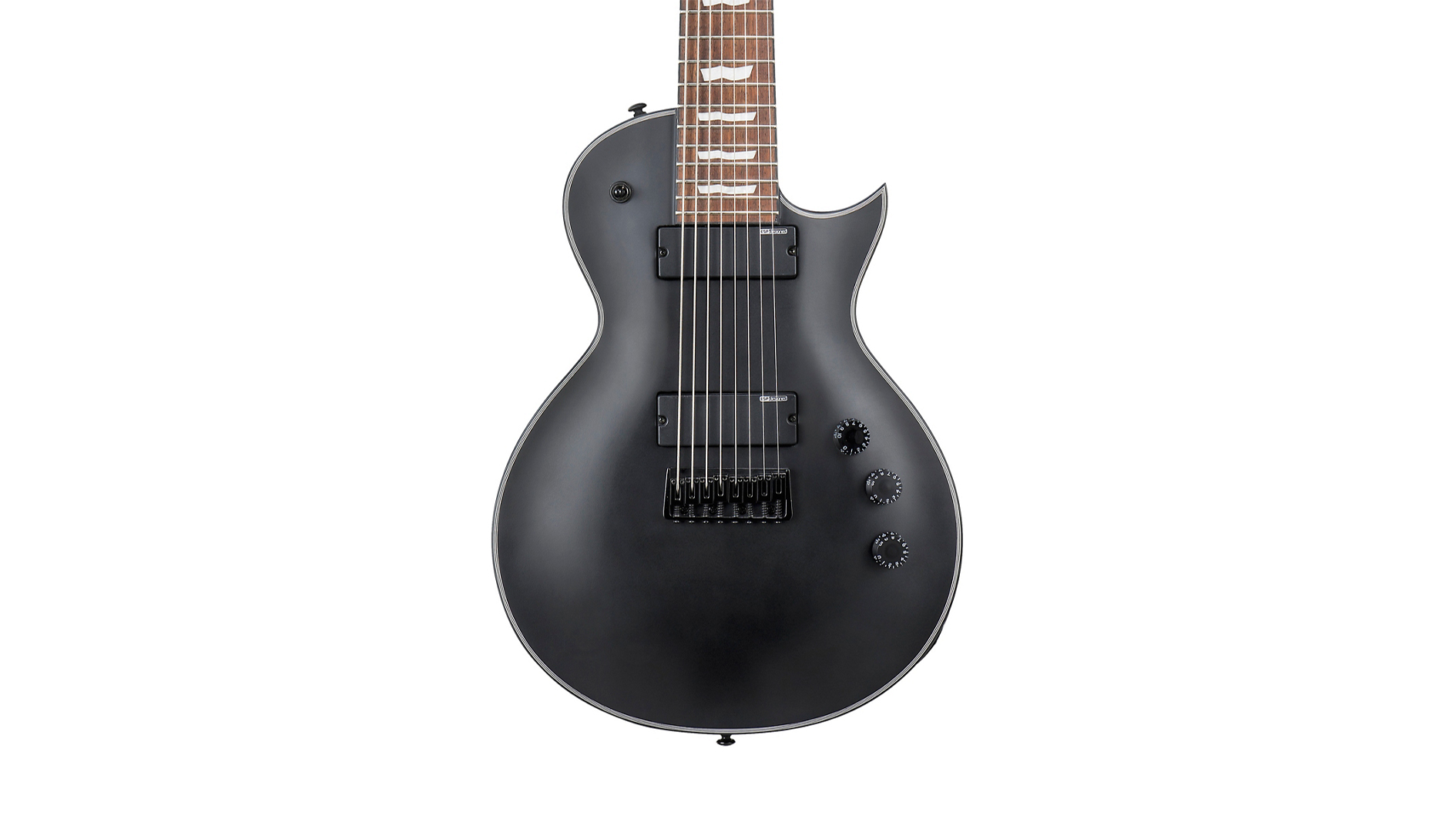
When trying out a seven- or eight-string guitar, you should play it through an amplification rig similar to one you already own or plan on buying. You’ll want to pay particularly close attention to the lowest bass frequencies while playing clean and distorted tones to determine if the clarity and definition meets your needs and preferences.
If the bass notes sound muffled or flabby or if they distort too quickly while other notes remain clean, you may want to try a different rig and/or an instrument with different style pickups. This also is a good time to listen for fret buzzing (which may or may not be easy to fix) and rattles coming from inside the instrument (in which case you should probably select another guitar).
Passive pickups work great with guitar and bass alike, but design features that work great for standard six-string guitars (windings, shape and strength of the magnetic field, etc.) don’t always work well for lower frequencies. Active pickups tend to deliver greater overall clarity across a wider frequency range, and the attack can be faster and more pronounced (which can be very desirable).
It mainly depends on which tonal characteristics matter more to you personally. If you prefer warm, fat tones with midrange emphasis and greater dynamic responsiveness, passive pickups may be better, but if you are more into precise clarity and brighter overall tone with a wider frequency range, active pickups can be a better choice.
Note that the selection of pickup configurations for most seven- and eight-string guitars is less varied than that for six-string electrics. In fact, the majority of these instruments have dual-humbucker designs, while only a handful have a pair of single-coil pickups, a single-coil in the neck or bridge position along with a humbucker, or, in very rare instances, three pickups (usually a single-coil in between neck and bridge humbuckers).
Many dual-humbucker models also have coil-split/tap features that provide single-coil tones. Most instruments also have only master volume and master tone controls, and many have only master volume controls, so if you prefer having separate volume and tone controls for each pickup or more sophisticated tonal shaping capabilities for active pickups, you may have to consider buying a custom-made instrument.
Amplification/effects
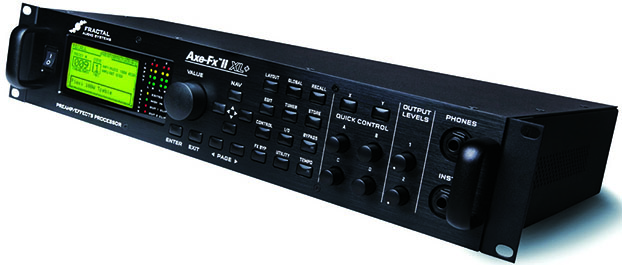
Most modern high-gain amplifiers can handle the extended bass frequency ranges of seven- and eight-string guitars pretty well, especially if you are primarily using distorted tones. However, excess distortion tends to emphasize the upper harmonics of bass notes over the fundamental frequencies, so the overall tone may not be as deep, booming and punchy as you’d expect or want it to be.
If you want more low-end boom and rumble, you really don’t need as much gain as most players would use for a standard six-string guitar, and you actually may prefer the tones of an amp with greater clean headroom that provides better clarity, attack and punch.
Speakers are a more important consideration as most 10- and 12-inch speakers designed for guitar have prominent midrange frequencies and significantly roll off bass frequencies starting around 100 to 70 Hz. Because the low B on a seven-string guitar has a fundamental frequency of about 62 Hz, that means the low B’s fundamental frequency could potentially be -10 to -20dB quieter than the fundamental frequency of the low E string.
Subjecting standard guitar speakers to lower bass frequencies also can cause them to distort earlier than they do when subjected to normal guitar frequencies, and in some cases the speakers may be more likely to blow out. Using speakers with a wider, flatter frequency response is one alternative, although these speakers can make regular guitar midrange frequencies sound cold and sterile.
Instead, it’s better to use a subwoofer with a built-in crossover to boost the lowest of low-end fundamental frequencies while still using a standard guitar cabinet for more satisfying guitar tones.
Many seven- and eight-string players prefer to use digital modeling amps like the Fractal Audio Axe-Fx II XL and AX8 or Line 6 Spider series heads in conjunction with a full-range P.A. system. This type of system is capable of handling a wider range of bass and treble frequencies while providing the rich midrange tones that guitarists prefer and are accustomed to.
Alternatives

Depending on how a guitarist plans on playing, a seven- or eight-string guitar might not be necessary and it may be better to use a six-string down-tuned standard guitar, long-scale guitar or baritone instead.
A seven-string guitar with the seventh string tuned to B provides only an additional five notes, yet it can present a somewhat dramatic conceptual shift (such as when playing chords on the bottom four strings) for certain players who are accustomed to six-string guitars in addition to the physical adjustments some guitarists will need to make to get used to playing instruments with wider necks and potentially longer scales.
If your band has two guitarists, it may make better sense for the rhythm guitarist to play a baritone and the lead guitarist to play a standard guitar if they mostly adhere to chord/riff (rhythm player) and full-range solo (lead player) roles but want heavier bottom-end punch to fill out the band’s sound. If you tend to dwell in the upper or lower strings almost exclusively you probably won’t need the extra string(s) or the challenge of learning the fingerings for a new set of chords.
And in some bands with lots of different instruments occupying similar frequency ranges (such as six-string piccolo bass, keyboards, horns and so on) the expanded frequency range of a seven- or eight-string guitar may just add to the sonic clutter and serve little useful purpose.
However, if you consistently use the guitar’s entire range and want more, then by all means a seven- or eight-string guitar is a worthy choice over the various six-string alternatives. A seven- or eight-string guitar may also help players get out of a stagnant creative rut by encouraging them to think about their instruments slightly differently, whereas a six-string baritone or down-tuned guitar wouldn’t necessarily light that spark.
The additional strings do provide certain advantages (such as making it possible to simultaneously play bass lines and treble chord voicings) that a six-string guitar can’t always replicate, so for some applications a seven- or eight-string guitar really is the only viable choice.
Brands

The variety of seven- and eight-string model guitars available today is truly staggering, and it can be difficult to know where to start. Companies that produce the largest selection of seven- and eight-string models include big names like ESP/LTD, Ibanez, Jackson and Schecter as well as up-and-coming specialists like Jericho, Legator, Strandberg and Strictly 7.
Other popular manufacturers of affordable seven-string guitars include Agile, B.C. Rich, Caparison, Carvin/Kiesel, Charvel, Dean, Ernie Ball Music Man/Sterling by Music Man, Epiphone, Michael Kelly, PRS and Washburn. Several of these companies (but not all) also offer eight-string models.
With so many companies producing seven- and eight-string guitars today, it’s safe to say that the instruments are here to stay and the selection of models will continue to evolve and expand in the years to come.
Recommended guitars
Looking for your next seven- or eight-string guitar? These are some of the top sellers right now:
Chris is the co-author of Eruption - Conversations with Eddie Van Halen. He is a 40-year music industry veteran who started at Boardwalk Entertainment (Joan Jett, Night Ranger) and Roland US before becoming a guitar journalist in 1991. He has interviewed more than 600 artists, written more than 1,400 product reviews and contributed to Jeff Beck’s Beck 01: Hot Rods and Rock & Roll and Eric Clapton’s Six String Stories.

